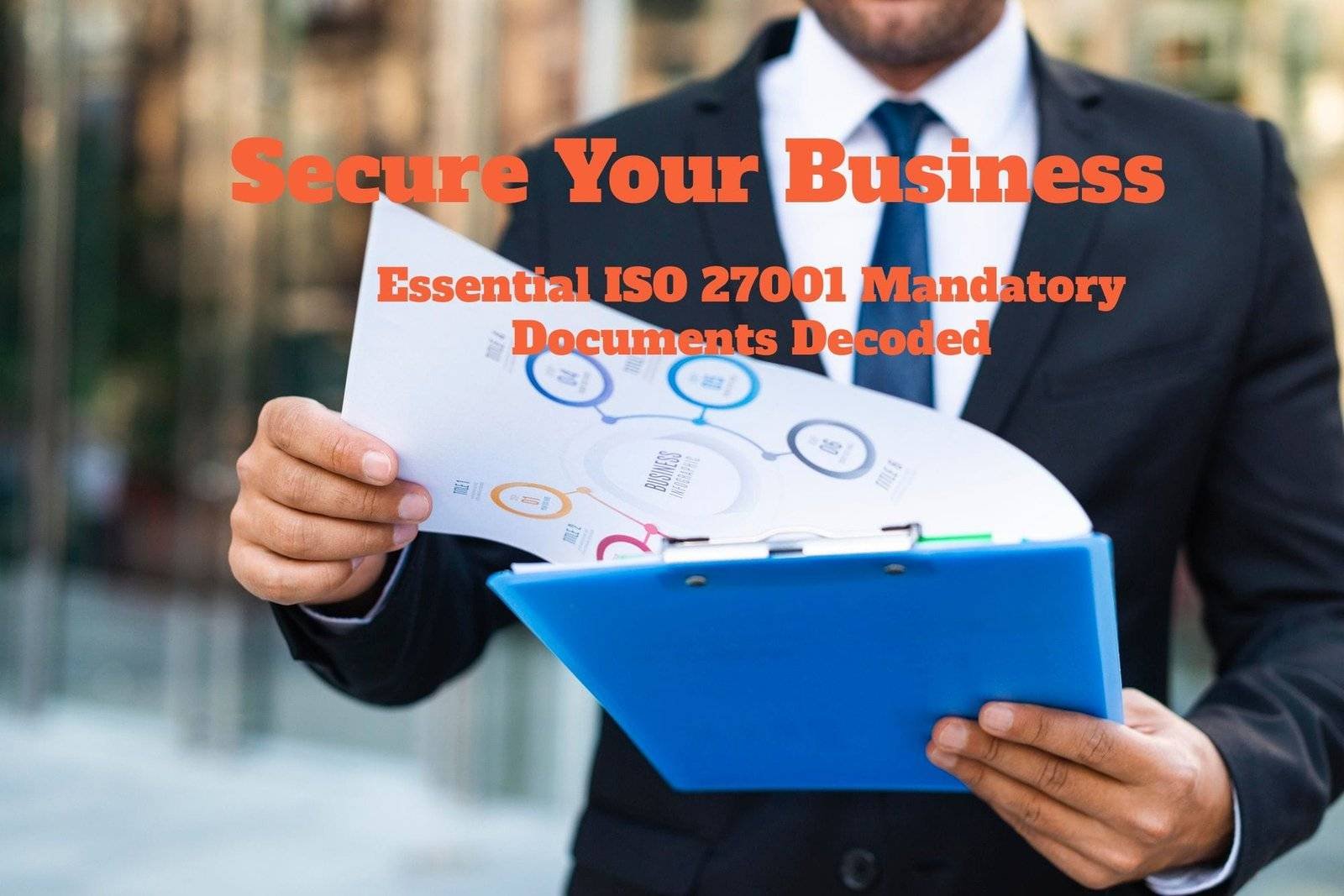Secure Your Business: Essential ISO 27001 Mandatory Documents Decoded
In today’s digital era, protecting sensitive data has become crucial for companies of all kinds. Businesses must have strong frameworks in place to guarantee the security and integrity of their data since cyber threats are increasing. A globally recognized standard for information security management systems (ISMS) is ISO 27001, which serves as one such framework. We’ll explore the crucial ISO 27001 required documents in this post, which companies need to read and use to properly protect their operations.
Introduction to ISO 27001
An international standard known as ISO 27001 offers a framework for creating, putting into practice, maintaining, and continuously enhancing an information security management system. Ensuring the confidentiality, integrity, and availability of sensitive data is made possible by its assistance in helping companies recognize, manage, and reduce information security threats.
Importance of ISO 27001 for Businesses
Customers, partners, and stakeholders will see your commitment to information security best practices and gain trust from your implementation of ISO 27001. By proactively identifying and addressing security vulnerabilities, it helps companies to reduce their risk of data breaches, financial losses, and reputational harm.
Understanding Mandatory Documents
In the context of ISO 27001, required documents are essential to the creation and maintenance of a successful information security management system (ISMS). These documents guide businesses through the process of identifying, assessing, and managing information security risks. They provide the foundation around which the entire framework is based. Let’s take a closer look at the crucial paperwork needed to comply with ISO 27001:
Policy Statement
The organization’s commitment to information security is stated in the policy statement, which forms the basis of the ISMS. It describes the general goals, tenets, and obligations of the protection of confidential information. An effective policy statement establishes the security culture of the company and offers a framework for decision-making at all levels.
Scope of the ISMS
Determining the limits within which information security measures will be implemented requires defining the ISMS’s scope. This involves identifying the locations, processes, assets, and organizational units that the ISMS covers. Organizations can make sure that their security efforts are targeted and in line with business goals by precisely defining the scope.
Risk Assessment and Treatment Process
The foundation of ISO 27001 is the risk assessment and treatment process, which aids in identifying and prioritizing information security issues for businesses. This is calculating the probability and possible results of security incidents by carefully evaluating threats, vulnerabilities, and impacts. Organizations must design and put into place the proper controls to reduce or eliminate risks after they have been recognized. Transparency, accountability, and consistency in risk management initiatives are ensured by documenting this procedure.
Other Essential Documents
Organizations may also need to create other rules, processes, guidelines, and records to support their ISMS, in addition to the above-listed necessary papers. These could consist of:
- Information security policies
- Access control procedures
- Incident response plans
- Business continuity plans
- Security awareness training materials
- Records of management reviews and internal audits
Every one of these documents has a distinct function in ensuring the efficiency and longevity of the ISMS. Organizations can confidently discuss the intricate details of information security management with their help, as they offer clarity, advice, and responsibility.
Leadership’s Role in Document Management
Strong leadership engagement and support are necessary for effective document management. Leaders must ensure that policies, methods, and guidelines are efficiently conveyed and followed by all members of the company.
Documenting Information Security Objectives

Documenting Information Security Objectives
Any ISO 27001 implementation must have defined, quantifiable information security objectives to be successful. These goals give the organization the structure for defining its information security objectives and directing its activities in that direction. Let’s explore the significance of information security goal documentation as well as the efficient ways in which businesses can set and maintain them:
Why Document Information Security Objectives?
- Alignment with Business Goals: Information security initiatives are tightly matched with the organization’s larger goals and objectives when their objectives are documented. Organizations can gain support from stakeholders and prove the worth of information security expenditures by coordinating security goals with business objectives.
- Measurable Performance Indicators: Organizations can monitor their progress and assess the success of their information security initiatives by setting clear, quantifiable goals. Organizations can evaluate their performance about security objectives over time and pinpoint areas for improvement by developing key performance indicators (KPIs).
- Risk Prioritization and Mitigation: By establishing information security goals, businesses may prioritize their security efforts according to the degree of danger to vital resources and operations. Organizations may reduce their exposure to possible attacks and the chance of security incidents by identifying and resolving the most important security risks.
Establishing Information Security Objectives
- Identify Key Security Priorities: To start, decide which critical information security areas inside the company need the most attention. This could include adhering to legal standards, improving incident response capabilities, protecting sensitive data, and making sure the system is available.
- Define Specific Objectives: Following the identification of the top priorities for each area, establish attainable goals that are specific to that area. Implementing encryption for sensitive consumer data kept in databases is one goal associated with data protection, for instance.
- Set Measurable Targets: To track your progress toward each goal set measurable objectives or metrics. These metrics ought to be measurable and useful so that businesses can monitor performance and use data to make data-driven decisions.
Implementing ISO 27001 Controls
A collection of measures to handle different information security risks is specified by ISO 27001. Organizations must record the controls they have selected and demonstrate their efficacy in reducing risks.
Documenting Control Objectives and Controls
In the field of information security management, the efficacy and integrity of an organization’s ISO 27001 implementation depend heavily on the documentation of control objectives and related procedures. These documents offer an organized method for determining, putting into practice, and upholding the security precautions required to reduce risks and protect sensitive data. Now let’s take a closer look at the procedure for recording control goals and controls:
Understanding Control Objectives
- Definition: Control objectives are defined as the intended results or objectives that an organization hopes to accomplish by putting particular controls in place. Usually, these goals are in line with the organization’s risk management priorities, information security policies, and legal obligations.
- Purpose: Control objectives serve as a foundation for specifying the range and priorities of security measures inside the company. They aid in locating the main points of exposure or vulnerability and direct the choice and application of suitable solutions to mitigate these risks.
- Alignment with ISO 27001: Control objectives ought to be in line with the guidelines provided by ISO 27001, which defines a thorough set of controls for a variety of information security-related areas. Organizations can demonstrate adherence to best practices and assure compliance with ISO 27001 by mapping control objectives to requirements.
Documenting Controls
- Selection of Controls: Controls should be chosen with consideration for the organization’s unique security needs, industry standards, and risk profile in mind. When selecting controls for implementation, take into account variables including the organization’s size, complexity, and operating environment.
- Description of Controls: Clearly state the goal, operation, and anticipated results of each control that has been chosen in your documentation. Provide details regarding the control’s application, scope, dependencies, and interactions with other controls.
- Implementation Guidance: Advice on how each control should be put into practice inside the company, including the specific actions, protocols, or technological solutions needed to ensure compliance. Timelines, resource requirements, and potential implementation obstacles should all be taken into account.
- Responsibility and Accountability: Assign teams or specific persons within the organization with accountability for the implementation and upkeep of each control. Establish clear roles and duties to promote accountability and efficient departmental coordination.
Record Management Procedures
According to ISO 27001, record management practices are an essential part of an organization’s information security management system (ISMS). These policies specify how documents must be made, obtained, kept, preserved, and destroyed in compliance with corporate, legal, and regulatory obligations. Let’s explore record management processes’ significance and the essential components in more detail:
Importance of Record Management Procedures
- Legal and Regulatory Compliance: Record management practices make sure businesses abide by all applicable laws and regulations regarding the keeping and disposal of records. This includes regulations that require the privacy and protection of personal data, such as the General Data Protection Regulation (GDPR).
- Evidence of Compliance: Documented proof of compliance with ISO 27001 requirements and other relevant standards is provided by effective record management. Records make audits, evaluations, and certifications easier by providing evidence that security controls are in place and functioning as intended.
- Risk Mitigation: Reducing the possibility of data loss, illegal access, and non-compliance is possible with good record management. Organizations can reduce the risk of security events and shield confidential data from unauthorized disclosure by implementing clear policies for record generation, access control, and retention.
Key Elements of Record Management Procedures
- Record Identification: Determine the kinds of records—both electronic and paper—that the organization creates and keeps. Financial records, employee files, client data, transaction logs, and audit trails are a few examples of these.
- Record classification: Group documents according to their significance, sensitivity, and length of retention needs. To choose the right handling and storage techniques, distinguish between temporary and permanent records as well as private, restricted, and public records.
- Record Creation and Capture: Specify processes for the systematic and uniform creation, capture, and documentation of records. Indicate who is in charge of keeping records, which information needs to be included, and how they should be taken and added to the record management system.
- Record Storage and Access: Establish rules for the safe storage of records to guard against loss, alteration, and illegal access. Put in place authentication procedures, encryption, and access controls to protect private information from manipulation or unauthorized exposure.
- Record Retention and Disposal: Based on business, legal, and regulatory needs, ascertain how long to keep various kinds of records. After a record’s retention time has passed or it is no longer required for business purposes, establish protocols for its safe destruction or disposal.
Continuous Improvement and Review
- Regular Audits and Assessments: To ensure adherence to ISO 27001 standards and identify opportunities for enhancement, conduct regular checks and evaluations of record management protocols. To improve record management procedures, get input from relevant parties and consider the audit’s results.
- Training and Awareness: To teach staff members about record management rules, procedures, and best practices, offer training and awareness efforts. Give employees the tools they need to follow record-keeping procedures and understand how crucial it is to handle records properly to protect sensitive data.
- Policy Review and Updates: To take into account changes to business practices, technology, laws, or security risks, policies and procedures about record management should be reviewed and updated regularly. Make sure that company objectives and industry standards are still met by record management procedures.
Training and Awareness Documents

Training and Awareness
The development of an information security culture inside an organization is significantly helped by training and awareness materials. By providing them with knowledge of information security risks, policies, procedures, and best practices, these materials enable staff members to identify and successfully combat possible threats. Let’s explore the significance of training and awareness papers in more detail, as well as the efficient creation and application of them by organizations:
Importance of Training and Awareness
- Risk mitigation: The first line of defense against risks to information security is well-trained personnel. Organizations can lessen the possibility of data breaches and other security incidents by educating staff members about typical threats including malware infections, phishing scams, and social engineering techniques. This will enable staff members to recognize and address security incidents early on.
- Compliance: Policies, processes, and regulatory requirements about information security are understood and followed by employees with the support of training and awareness campaigns. Organizations can mitigate the risk of non-compliance and related penalties by providing staff with appropriate training regarding their roles and duties in data protection and privacy.
- Behavioral Change: Employees’ behavior can be positively impacted by training and awareness campaigns, which can help create a culture where information security is valued and integrated into everyday operations. This culture change encourages responsibility, openness, and cooperation, which improves the information security management system’s overall efficacy inside the company.
Key Elements of Training and Awareness Documents
- Policy Communication: Information security policies, such as permissible usage guidelines, data management practices, and incident response procedures, should be made explicit in training and awareness materials. Workers need to be aware of their information security rights and obligations as well as the repercussions of breaking the law.
- Security Awareness Training: Provide training materials that inform staff members about typical security risks, including malware, social engineering, phishing scams, and password security. Provide examples, case studies, and interactive activities together with helpful advice on how to identify and handle these dangers.
- Role-Based Training: Develop course materials that are specifically customized for the duties and tasks of various employee groups inside the company. IT personnel, for instance, might need more technical training on system setups and security controls, whilst non-technical staff would only need basic awareness training on email security and password hygiene.
- Ongoing Education: Since best practices and dangers related to information security are always changing, it’s critical to give staff members regular training and updates. Establish a routine for security awareness training, newsletters, and internet resources to educate staff members about new security risks and reinforce important security principles.
- Training Delivery Methods: To meet a range of learning styles and preferences, take into account various training and awareness campaigns’ delivery techniques. Posters, newsletters, email reminders, interactive e-learning modules, live workshops, and online courses are a few examples of this. To increase effectiveness and engagement, combine different strategies.
Communication Documents
Ensuring that all employees within a company understand and adhere to information security policies, processes, and best practices requires effective communication. Communication documents give staff members, stakeholders, and outside partners a way to learn about information security regulations, updates, incidents, and awareness campaigns. Let’s explore the significance of communication documents and the essential components that go into them:
Importance of Communication
- Clarity and Consistency: Information security policies, processes, and guidelines are communicated throughout the company clearly and uniformly thanks to communication papers. Ensuring that all parties are in agreement with information security expectations and preventing misunderstandings requires clear communication.
- Timely Updates and Alerts: Organizations may deliver fast updates and notifications about new security threats, policy revisions, and regulatory changes by using communication documents. Prompt communication ensures that staff members are cognizant of any hazards and can adopt suitable measures to protect confidential data.
- Incident Response: To coordinate response efforts, notify impacted parties, and reduce the impact of an incident, good communication is crucial in the event of a security incident or breach. The processes for reporting problems, alerting stakeholders, and handling correspondence with the media and regulatory bodies are described in communication documents.
Review and Improvement Documents
Maintaining an efficient information security management system (ISMS) in compliance with ISO 27001 requirements requires constant evaluation and development. The framework for assessing the effectiveness of the ISMS, finding areas for improvement, and putting corrective and preventive measures in place to address weaknesses and vulnerabilities is provided by review and improvement documents. Let’s examine the significance of review and improvement documents as well as the essential components:
Importance of Review and Improvement
- Enhancing Effectiveness: Organizations can evaluate the efficiency of their information security policies, procedures, and controls by implementing review and improvement processes. Organizations can boost security posture by taking proactive actions to identify gaps, weaknesses, and opportunities for improvement within the ISMS by conducting frequent reviews.
- Adapting to Change: Information security risks, technology, and legal requirements are ever-changing in the modern business climate. The procedures of review and improvement offer the adaptability and nimbleness required to deal with these changes efficiently. Organizations may make sure that their ISMS is current and robust over time by keeping up with evolving risks and best practices.
- Demonstrating Compliance: To be compliant with ISO 27001, enterprises must show that they are dedicated to improving information security management constantly. Review and improvement records, which record the outcomes of evaluations, reviews, and organizational improvement projects, act as proof that the criterion has been met.
Business Continuity and Disaster Recovery Plans
Plans for disaster recovery and business continuity are crucial parts of every organization’s risk management approach because they offer the structure for resuming regular operations in the case of a cyberattack, natural disaster, or other unfavorable circumstances. The procedures, resources, and roles that are needed to ensure business resilience and lessen the effects of disruptions on stakeholders, customers, and operations are provided in these plans. Let’s explore the significance of disaster recovery and business continuity strategies, as well as the essential components involved:
Importance of Business Continuity and Disaster Recovery
- Maintaining Operations: Plans for business continuity and disaster recovery ensure that crucial operations can go on both during and after a disruptive incident. Organizations can prioritize recovery efforts and reduce downtime by identifying important processes, resources, and dependencies.
- Protecting Assets: Plans for business continuity and disaster recovery assist in shielding important resources, such as staff, equipment, facilities, and data, from the effects of crises or natural disasters. Through the use of strategies like data backup, redundancy, and alternate work locations, businesses can reduce the possibility of asset loss or damage.
- Preserving Reputation: A business’s commitment to preparedness and resilience is reflected in its successful business continuity and disaster recovery strategy. Even in the face of difficulty, prompt and efficient responses to interruptions help preserve consumer confidence, brand credibility, and market reputation.
Vendor Management Policies and Procedures
For businesses to set up efficient methods for choosing, verifying, overseeing, and managing outside suppliers and vendors, vendor management rules and procedures are crucial. These policies and processes minimize the risks connected with outsourcing, protect sensitive data shared with outside parties, and ensure that vendors follow the organization’s security and compliance standards. Now let’s explore the significance of vendor management rules and procedures as well as the essential components:
Importance of Vendor Management Policies and Procedures
- Risk Mitigation: By ensuring that suppliers adhere to the organization’s security, privacy, and compliance standards, vendor management policies and processes assist reduce the risks associated with outsourcing. Organizations can detect and mitigate possible hazards before they become more serious by carrying out due diligence and keeping an eye on vendor actions.
- Compliance Assurance: Robust vendor management policies and processes ensure adherence to legal mandates, contractual commitments, and industry standards concerning vendor associations. Organizations can prevent non-compliance problems and related fines by emphasizing expectations and requirements for vendors.
- Protecting Sensitive Information: Vendor management rules and processes protect proprietary corporate information, intellectual property, and consumer data that are exchanged with outside vendors and suppliers. Organizations may protect against sensitive information being misused or disclosed without authorization by putting in place controls for data integrity, confidentiality, and access.
Conclusion: Securing Your Business with ISO 27001 Mandatory Documents
For businesses of all sizes and sectors, protecting sensitive data and reducing cybersecurity risks is critical in today’s digitally connected and more interconnected world. Strong information security management systems (ISMS) built on global standards like ISO 27001 are vital for protecting against cyberattacks, data breaches, and regulatory non-compliance.
We have covered all of the ISO 27001 required documents in this extensive guide, which are crucial for setting up, executing, and maintaining an efficient ISMS. Every component—from training and awareness initiatives to rules and procedures—is essential to protecting confidential data, encouraging adherence, and developing an organizational culture of security awareness.
Organizations can boost their resistance to security risks and ensure the confidentiality, integrity, and availability of their information assets by creating clear policies and procedures, carrying out frequent risk assessments, and offering continual training and awareness campaigns. In addition, companies can demonstrate their commitment to protecting sensitive data, gain a competitive advantage, and improve customer trust by following ISO 27001 standards and putting best practices in information security management into effect.
Businesses must be alert, proactive, and flexible in responding to new security threats and legal obligations as they develop and encounter new difficulties in an increasingly digital environment. Organizations may improve their security posture, reduce risks, and set themselves up for long-term success in a continuously changing threat landscape by utilizing the guidelines and practices provided in this guide.







